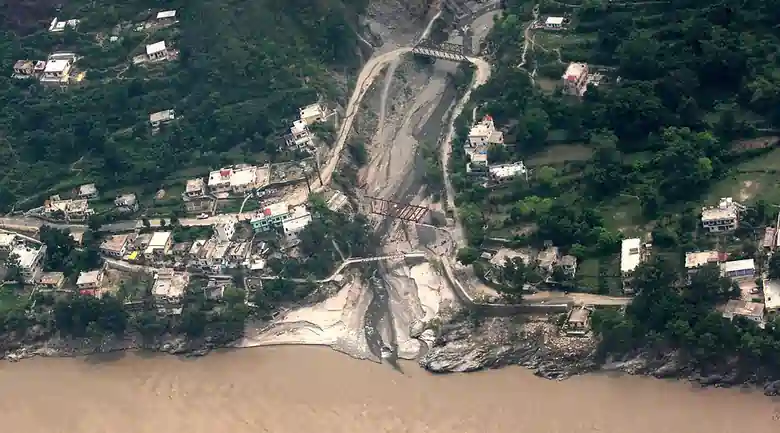New Delhi: India’s Himalayan Region is grappling with an escalating environmental crisis as Glacial Lake Outburst Floods (GLOFs) pose severe risks to lives, infrastructure, and ecosystems. A recent report by the Central Water Commission (CWC) reveals that glacial lakes and water bodies across the Himalayas have expanded by 11% since 2011, driven by climate change and rising temperatures.

What Are Glacial Lake Outburst Floods (GLOFs)?
A Glacial Lake Outburst Flood (GLOF) is defined as the sudden and rapid release of water from a lake fed by glacier melt. These lakes form at the side, in front, within, beneath, or on the surface of glaciers. The catastrophic failure of natural dams—often made of loose moraine (rock and debris) or ice—triggers devastating floods downstream. Notable examples include the 2023 South Lhonak GLOF in Sikkim and the 2013 Chorabari GLOF in Uttarakhand, which caused widespread destruction.
Types of Glacial Lakes in the Himalayas
The Indian Himalayan Region (IHR) hosts approximately 28,000 glacial lakes across 11 major river basins, with 7,500 located within India. These lakes are primarily categorized into two types:
- Supraglacial Lakes: Formed by meltwater accumulating in depressions on glacier surfaces, these lakes are highly vulnerable to summer melting.
- Moraine-Dammed Lakes: Located near glacier snouts and held by loose debris or ice-core moraines, these lakes are structurally weak and prone to sudden failure under external stressors like avalanches or excessive meltwater pressure.
Factors Driving GLOF Risks in India
Several natural and anthropogenic factors contribute to the increasing susceptibility of the IHR to GLOFs:
Triggers of GLOFs
- Ice Avalanches and Landslides: Approximately two-thirds of GLOF events are triggered by mass movements such as ice avalanches or landslides, which displace water and breach dams. The 2021 Chamoli disaster and the 2023 South Lhonak GLOF are stark examples.
- Meltwater Pressure: Excessive meltwater exerts pressure on weak moraine dams, leading to sudden breaches, as seen in the 2013 Chorabari GLOF.
- Seismic Activity: The Himalayas fall under Seismic Zones IV and V, making them highly prone to earthquakes that destabilize glacial lakes. The 2015 Nepal Earthquake significantly altered lake stability, raising GLOF risks.
- Extreme Rainfall and Cloudbursts: Intense rainfall events, such as those during the 2013 Kedarnath tragedy and the 2023 North Sikkim GLOF, stress moraine dams by raising lake water levels.
- Internal Seepage: Piping erosion within moraine dams weakens their structure, causing sudden failures, as observed in the 1985 Dig Tsho GLOF in Nepal.
Climate Change and Rising Temperatures
The record-breaking heat of 2023 and 2024, coupled with localized extreme heat pockets, has accelerated glacial melt across the Himalayas. According to the International Centre for Integrated Mountain Development (ICIMOD), over 70% of the 700 recorded GLOF events since 1833 have occurred in the last 50 years, underscoring the impact of climate change. The year 1980 saw the highest number of GLOF incidents (15), followed by 2015 (13), with other significant years including 1973, 1974, 2002, and 2010, each recording 10 events.
Unregulated Infrastructure Development
The construction of hydropower projects, roads, and settlements in fragile glacial and riverine zones destabilizes ecosystems. The 2023 South Lhonak GLOF destroyed the Rs 16,000 crore Chungthang hydropower project and the Teesta-III Dam, highlighting the vulnerability of infrastructure to GLOFs.
India’s Vulnerability to GLOFs
The IHR’s geographic and climatic conditions amplify its vulnerability to GLOFs:
- Geographic Extent: With 7,500 glacial lakes above 4,500 meters, India faces challenges in monitoring remote, high-altitude regions. The short summer window limits physical surveys, and the lack of automated weather and water monitoring systems hampers predictive capabilities.
- Lake Expansion: ISRO’s satellite data (1984–2023) indicates that 676 of the 2,431 glacial lakes larger than 10 hectares identified in 2016–17 have significantly expanded, with 601 more than doubling in size. The CWC’s September 2024 report notes a 10.81% area increase in 544 glacial lakes and 358 water bodies over the past decade.
- Past Disasters: The 2013 Chorabari GLOF triggered a cascading disaster during the Kedarnath tragedy, involving cloudbursts, landslides, and massive fatalities. The 2023 South Lhonak GLOF increased silting in the Teesta River, reducing riverbed capacity and raising downstream flood risks.
- Downstream Risks: GLOFs cause widespread destruction of homes, infrastructure, and hydropower projects. They also lead to biodiversity loss and increased sediment loads in rivers, exacerbating secondary flooding risks.
Transboundary Risks with Neighboring China
The trend of expanding glacial lakes is not limited to India. In China, two large lakes and 14 water bodies over 50 hectares have expanded by more than 40%, posing transboundary risks. These larger lakes are growing at a faster rate than those in India, heightening the potential for catastrophic GLOFs that could impact downstream communities in both countries.
India’s Mitigation Strategies for GLOF Risk
Recognizing the growing threat, India has shifted from post-disaster response to proactive risk reduction through comprehensive strategies:
National GLOF Mitigation Programme
The National Disaster Management Authority (NDMA) has launched a USD 20 million National Glacial Lake Outburst Flood (NGRMP) Risk Mitigation Project, targeting 195 high-risk glacial lakes across Arunachal Pradesh, Himachal Pradesh, Sikkim, and Uttarakhand. Coordinated through the Committee on Disaster Risk Reduction (CoDRR), the programme classifies lakes into four risk categories, with plans for further expansion under the 16th Finance Commission (2027–31).
Scientific and Technological Interventions
Since 2024, multi-institutional expeditions in six Himalayan states have employed advanced tools, including:
- Bathymetry: Measures water volume in glacial lakes.
- Electrical Resistivity Tomography (ERT): Detects ice-cores beneath moraine dams.
- Unmanned Aerial Vehicles (UAVs): Conducts terrain mapping and slope stability surveys.
- Synthetic Aperture Radar (SAR) Interferometry: Detects micro-slope shifts, enabling monitoring during clouded monsoon months.
- Automated Weather and Water Stations (AWWS): Installed in Sikkim, these stations relay real-time data every 10 minutes, including daily lake imagery.
The CWC monitors 902 critical glacial lakes and water bodies using satellite imagery, remote sensing, and cloud platforms like Google Earth Engine. Since 2009, the CWC has tracked 2,028 lakes larger than 10 hectares, prioritizing high-risk ones.
Early Warning Systems (EWS)
Following the devastating 2023 Sikkim GLOF, which claimed over 40 lives, the government launched the GLOF EWS Mission to establish early warning systems for 188 high-risk lakes. These systems aim to provide timely alerts to downstream communities, reducing the risk of loss of life and property.
Security Forces and Local Participation
In remote areas lacking automated systems, Indo-Tibetan Border Police (ITBP) personnel are trained for manual early warning. Local communities are actively involved in expeditions, ensuring cultural sensitivity at sacred sites and fostering trust through awareness campaigns and inclusive planning.
NDMA’s Five-Fold Strategy
The NDMA has adopted a comprehensive approach to GLOF mitigation:
- Hazard Assessment: Evaluate all vulnerable glacial lakes.
- Real-Time Monitoring: Install AWWS for continuous surveillance.
- Early Warning Systems: Deploy EWS in downstream areas.
- Risk Mitigation: Implement controlled lake drawdown and structural measures.
- Community Engagement: Promote awareness, preparedness, and trust-building.
The Way Forward: A Roadmap for Resilience
To address the escalating GLOF threat, India must adopt a multi-pronged approach:
- Advanced Monitoring: Deploy AWWS, remote sensing, and SAR for real-time surveillance. Introduce automated alerts, community-based warning systems, and controlled drainage via spillways to reduce lake volumes proactively.
- Indigenous Solutions: Encourage startups and academic research to develop cryosphere technologies. Strengthen moraine dams, enforce uniform construction codes, and ensure hydropower projects adhere to GLOF safety standards.
- Transboundary Cooperation: Foster data sharing and joint risk mitigation with Nepal and China to address transboundary risks.
- Community Empowerment: Train State Disaster Response Forces (SDRFs) for high-altitude response, conduct mock drills, and integrate resilience into local development planning.
Conclusion
India faces a high and growing risk from Glacial Lake Outburst Floods due to climate change, fragile topography, and infrastructural vulnerabilities. The combination of inaccessible terrain, expanding glacial lakes, and inadequate early warning systems underscores the need for urgent action. By leveraging advanced technology, fostering transboundary cooperation, and empowering local communities, India can build a resilient framework to mitigate GLOF risks and protect its Himalayan ecosystems and populations.
Frequently Asked Questions (FAQs)
1. What is a Glacial Lake Outburst Flood (GLOF)?
A Glacial Lake Outburst Flood (GLOF) is the sudden and rapid release of water from a lake fed by glacier melt, formed at the side, front, within, beneath, or on a glacier’s surface. It occurs when natural dams, made of moraine (loose rock and debris) or ice, fail due to triggers like ice avalanches, landslides, excessive meltwater pressure, earthquakes, or internal seepage. Notable examples include the 2023 South Lhonak GLOF in Sikkim and the 2013 Chorabari GLOF in Uttarakhand.
2. Why is India’s Himalayan Region particularly vulnerable to GLOFs?
The Indian Himalayan Region (IHR) hosts 7,500 glacial lakes, mostly above 4,500 meters, across 11 major river basins. These remote, high-altitude lakes are difficult to monitor due to limited access and a short summer window. Climate change, with record-breaking heat in 2023 and 2024, has accelerated glacial melt, expanding lakes by 11% since 2011. Unstable moraine dams, seismic activity (Himalayas fall under Seismic Zones IV and V), and unregulated infrastructure like hydropower projects increase vulnerability.
3. What are the main triggers of GLOFs in the Himalayas?
Approximately two-thirds of GLOFs are caused by ice avalanches or landslides, which displace water and breach dams. Other triggers include excessive meltwater pressure on weak moraine dams (e.g., 2013 Chorabari GLOF), seismic activity (e.g., 2015 Nepal Earthquake), extreme rainfall or cloudbursts (e.g., 2013 Kedarnath tragedy), and internal seepage causing piping erosion (e.g., 1985 Dig Tsho GLOF in Nepal).
4. What measures is India taking to mitigate GLOF risks?
India has shifted to proactive risk reduction through the National Disaster Management Authority’s (NDMA) USD 20 million National GLOF Risk Mitigation Project, targeting 195 high-risk lakes in Arunachal Pradesh, Himachal Pradesh, Sikkim, and Uttarakhand. The Central Water Commission (CWC) monitors 902 critical lakes using satellite imagery and Synthetic Aperture Radar (SAR). The GLOF Early Warning System (EWS) Mission targets 188 high-risk lakes, while technologies like bathymetry, Electrical Resistivity Tomography (ERT), and Automated Weather and Water Stations (AWWS) enhance monitoring. Local communities and ITBP personnel are involved in awareness and manual warning systems.
5. How does climate change contribute to the increasing GLOF threat?
Climate change drives glacial melt, with 2023 and 2024 being the hottest years on record, leading to an 11% expansion of glacial lakes since 2011. Over 70% of 700 recorded GLOF events since 1833 have occurred in the last 50 years, per ICIMOD data. Rising temperatures and localized extreme heat pockets weaken moraine dams and increase lake volumes, heightening the risk of catastrophic floods, as seen in the 2023 South Lhonak GLOF, which destroyed critical infrastructure.

